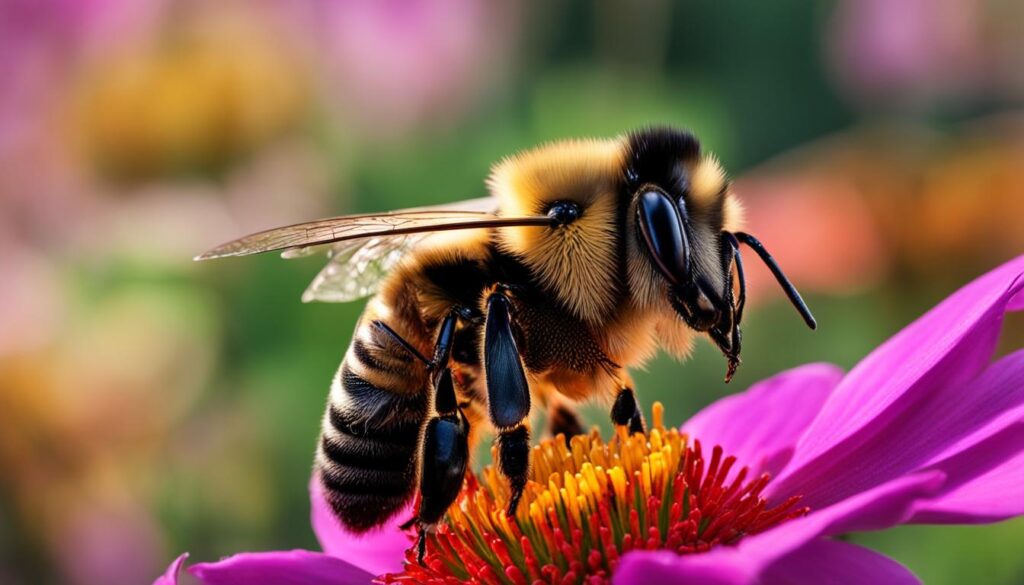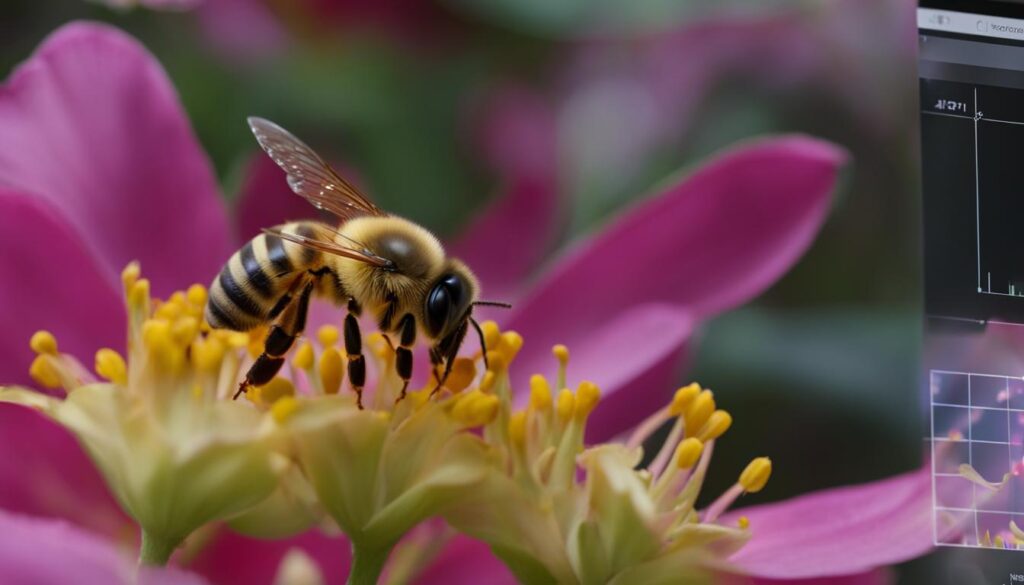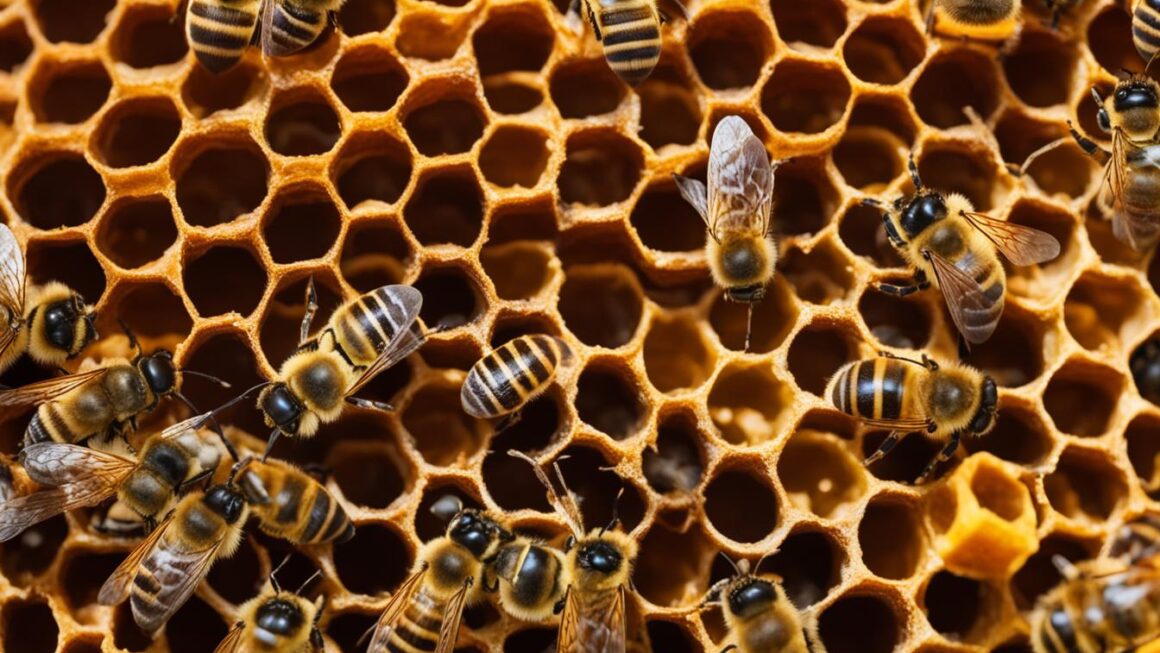Honey bees are fascinating creatures that exhibit a wide range of behaviors crucial for the functioning of their colonies. Understanding these behaviors is key to decoding the complex hive dynamics and promoting ecological awareness. Recent advancements in video technology have revolutionized the study of honey bee behavior, allowing for a more comprehensive observation of their actions within comb cells.
Key Takeaways:
- Decoding the Hive: Honey bee behavior studies provide valuable insights into the intricacies of hive communication.
- Understanding Bee Behavior: Observing individual honey bee behaviors helps unravel the organization and communication system within the colony.
- Honeybee Communication: Video analysis of honey bee behaviors enhances scientific understanding and facilitates knowledge sharing.
- Conservation Awareness: Studying honey bee behavior promotes awareness about the decline of honey bee populations and overall insect biodiversity.
- Ecosystem Impact: Honey bee behavior plays a crucial role in pollination, contributing to the reproductive success and biodiversity of ecosystems.
The Hidden Behaviors Within the Hive
Observing honey bee behaviors within comb cells provides valuable insights into the hidden world of hive communication. Through long-term video recordings, researchers have been able to observe and analyze the use of wax scales and existing nest material for comb remodeling, the storage of pollen and nectar in cells, brood care and thermoregulation, as well as hygienic practices like cannibalism, grooming, and surface cleaning. These videos have also captured rare behaviors such as mouth-to-mouth feeding by nurse bees to larvae and thermoregulation within cells containing developing brood. Decoding these behaviors helps scientists test hypotheses on social behaviors and promotes ecological awareness.
The Dynamics of Hive Communication
Honey bees communicate with each other through a complex system of dances and pheromones. One of the most well-known dances is the “waggle dance,” where forager bees use intricate movements to convey the location of food sources to their nestmates. By decoding these dances, researchers can gain valuable insights into the foraging behaviors and resource utilization of honey bee colonies. In addition to dances, bees also communicate through chemical signals known as pheromones. These chemical signals help coordinate various hive activities, such as brood rearing, nest defense, and queen recognition. Deciphering the bee language and understanding the intricacies of hive communication is crucial for understanding the functioning and dynamics of honey bee colonies.
| Hive Behavior | Insights from Video Observations |
|---|---|
| Comb remodeling | Video recordings have revealed the use of wax scales and existing nest material for comb remodeling, providing insights into the colony’s ability to adapt and optimize its hive structure. |
| Pollen and nectar storage | Researchers have observed the precise storage of pollen and nectar in cells, highlighting the efficiency and organization of honey bee colonies in resource management. |
| Brood care and thermoregulation | Video analysis has enabled the study of brood care behaviors and the regulation of temperature within cells, revealing the complex mechanisms that ensure the survival and development of honey bee offspring. |
| Hygienic practices | Through video recordings, scientists have gained insights into hygienic practices such as cannibalism, grooming, and surface cleaning, shedding light on the colony’s defense against pathogens and parasites. |
“Decoding these hidden behaviors within the hive not only expands our understanding of honey bee biology but also has important implications for conservation and management strategies. By deciphering the complex language of honey bees and unraveling the intricate dance of communication, we can better protect and support these vital pollinators and the ecosystems they inhabit.”
In summary, the study of hidden honey bee behaviors within the hive through video analysis has provided valuable insights into hive communication, resource management, and colony dynamics. Decoding bee language and deciphering complex dances has allowed scientists to unravel the intricate workings of honey bee colonies and understand their ecological significance. By continuing to explore these hidden behaviors, researchers can further enhance our understanding of honey bee biology and develop effective strategies for honey bee conservation and management.
The Importance of Individual Behaviors
Worker honey bees exhibit a range of behaviors that significantly contribute to the overall organization and functioning of the hive. These individual behaviors involve the use of wax scales and nest material for comb construction, the collection and storage of pollen and nectar, the care of the brood, and the regulation of hive temperature. However, there are also unique behaviors that have not been extensively documented, such as comb remodeling, mouth-to-mouth feeding between nurses and larvae, and pollen stamping by foragers.
Studying these individual behaviors is crucial for understanding the intricate organization of the hive and the communication system within the colony. Interpreting bee vibrations and decoding hive organization allows scientists to uncover the underlying mechanisms behind these behaviors and their importance in maintaining the hive’s functionality. By observing and analyzing these behaviors, researchers gain valuable insights into the division of labor and coordination among worker bees, as well as the overall health and productivity of the colony.
The Role of Worker Behaviors in Hive Functionality
Honey bees are known for their remarkable ability to perform specific tasks and adapt their behaviors based on the needs of the colony. For example, worker bees collect pollen and nectar from flowers and store them in cells within the hive. This process is crucial for the survival of the colony, as it provides a constant food supply for the brood and adult bees. Additionally, worker bees engage in brood care, ensuring the proper development and well-being of the larvae.
Another important behavior exhibited by worker bees is their role in maintaining hive temperature. Honey bees are known to regulate the temperature within the hive by fanning their wings to cool the colony or clustering together to generate heat during colder periods. This precise thermoregulation is vital for the survival of the brood and the overall functioning of the hive.
Overall, the study of individual honey bee behaviors provides valuable insights into the complex social organization of honey bee colonies. By decoding these behaviors and understanding their significance in hive functionality, researchers can develop strategies to promote the health and well-being of honey bee populations and ensure the conservation of these essential pollinators.

Altruistic Behaviors in Honey Bees
Honey bees are known for their remarkable altruistic behaviors, which play a crucial role in the overall functioning of the colony. One notable example of altruism is retinue behavior, where worker bees deactivate their own ovaries and assist in tending to the queen and her eggs. This behavior benefits the queen’s ability to produce offspring while the worker bees remain sterile, ensuring the survival and prosperity of the entire hive.
Recent studies have shed light on the genetic inheritance of altruistic behaviors in honey bees. It has been found that genes inherited from the mother are responsible for altruistic behavior, while genes inherited from the father do not result in the same level of altruism. This discovery highlights the intricate dynamics of honey bee colonies and the influence of genetic factors on their social behaviors.
“Altruistic behaviors in honey bees, such as retinue behavior, are essential for the survival and success of the entire colony.”
The genetic basis of honey bee altruism is a fascinating area of research with implications for our understanding of social behavior and evolutionary genetics. By further exploring the genetic mechanisms behind altruistic behaviors, scientists can gain insights into the complex interplay between genes, behavior, and social organization within honey bee colonies. This knowledge may also have broader implications for the study of altruism in other social insects and even in humans.
Overall, the study of altruistic behaviors in honey bees offers a captivating glimpse into the intricate workings of these remarkable creatures. By unraveling the genetic and behavioral factors that drive altruism, researchers deepen our understanding of honey bee colonies and contribute to the conservation and management of these essential pollinators.
The Battle of Genetics in Altruistic Behavior
Evolutionary genetics and gene expression play a significant role in understanding the intricate mechanisms of altruistic behavior in honey bees. The Kinship Theory of Intragenomic Conflict sheds light on the conflict within the honey bee genome regarding which behaviors to support or not support. This conflict arises from the different interests of the genes inherited from the mother and father bees. In honey bees, genes inherited from the mother play a crucial role in promoting altruistic behavior, benefiting worker bees in helping their mother and sisters who share more of their genes. This genetic conflict can be observed through gene regulatory networks, which exhibit a bias in gene expression from specific parents.
According to a study by Smith et al., genes inherited from the mother result in altruistic behavior, while genes inherited from the father do not exhibit the same effect. This finding suggests that the genetic control of altruism in honey bees is more complex than previously thought, with specific genetic variations influencing behavioral traits. By unraveling the genetic factors involved in altruistic behavior, researchers can gain a deeper understanding of the evolutionary dynamics within honey bee colonies.
“The Kinship Theory of Intragenomic Conflict sheds light on the conflict within the honey bee genome regarding which behaviors to support or not support.”
Table: Comparative Gene Expression in Altruistic Behavior
| Genes Inherited | Parent | Altruistic Behavior |
|---|---|---|
| From the Mother | Worker Bee | Yes |
| From the Father | Worker Bee | No |

The battle of genetics in altruistic behavior reveals the complex interplay between genes and behavior in honey bees. Understanding the evolutionary genetics and gene expression involved in altruism allows us to gain insights into the intricate social organization and dynamics of honey bee colonies. Further research in this field will deepen our understanding of the genetic control of honey bee behaviors and contribute to the broader study of animal behavior and evolution.
The Role of Video Analysis in Bee Behavior Research
Video analysis has revolutionized the study of honey bee behaviors within the hive. By recording individual honeycomb frames and even cells from within glass-framed observation hives, researchers can observe and analyze various honey bee behaviors at the individual level. This method provides a unique insight into behaviors such as egg laying by the queen, embryonic hatching and larval cocooning, inspection and feeding of larvae by nurse bees, comb remodeling, pollen and nectar storage, and hygienic practices.
Video analysis enables researchers to closely examine the intricate details of honey bee behavior, identifying patterns and connections that may not be easily observable through traditional methods. By analyzing the movements, interactions, and behaviors captured on video, scientists can uncover valuable information about the social organization, communication, and ecological impact of honey bee colonies.
Benefits of Video Analysis in Bee Behavior Research
There are several key benefits to using video analysis in bee behavior research:
- Improved accuracy and precision: Video recordings allow researchers to review and analyze honey bee behavior multiple times, ensuring accurate observations and measurements.
- Real-time and slow-motion playback: Video analysis enables researchers to observe and study honey bee behavior in real-time or slow-motion, providing a more in-depth understanding of their movements and interactions.
- Non-invasive monitoring: Video recordings offer a non-invasive method of monitoring honey bee behavior, reducing disturbance to the colony while still capturing valuable data.
By utilizing video analysis in bee behavior research, scientists can gain valuable insights into the complex world of honey bee colonies, further enhancing our understanding of these remarkable creatures and their role in our ecosystem.

Honey Bee Behaviors for Educational Purposes
The extensive collection of video recordings showcasing honey bee behaviors within the hive serves as a valuable educational resource. These videos offer a visual and dynamic understanding of honey bee behavior, allowing for enhanced ecological awareness among students, beekeepers, the media, and the general public. Additionally, these videos help raise awareness about the critical decline of both honey bee populations and overall insect biomass and diversity. The accessibility of this material supports efforts to educate and promote conservation and understanding of these essential pollinators.
By providing educational videos, we can foster a deeper appreciation for the vital role honey bees play in our ecosystems. These videos allow viewers to witness the complexities of hive communication, individual behaviors, and even altruistic tendencies within the colony. As the decline of insect populations becomes increasingly concerning, it is crucial to raise awareness and inspire actions that promote honey bee conservation and the preservation of biodiversity.
Through educational videos, individuals can gain firsthand knowledge of honey bee behaviors and their ecological significance. These videos can be utilized in classrooms to engage students in interactive learning experiences, fostering a connection with nature and promoting a sense of responsibility towards the environment. By highlighting the decline of honey bee populations, these videos also encourage individuals to take action, whether it be creating pollinator-friendly gardens, supporting local beekeepers, or advocating for policies that protect pollinators.
The Power of Visual Learning
Visual learning is a powerful tool in education, and educational videos showcasing honey bee behaviors tap into this potential. These videos provide a captivating way to learn about the intricate world of honey bees, their behaviors, and the challenges they face. By utilizing this medium, we can effectively communicate the importance of honey bee conservation and the need for action to protect these remarkable insects and the ecosystems they support.
The Impact of Hive Behavior on Ecosystems
Honey bee behavior has a significant impact on ecosystems, particularly in terms of pollination. Honey bees play a crucial role in the pollination of a wide range of plants, contributing to the reproduction and biodiversity of ecosystems. Their foraging activities result in the transfer of pollen from the male parts of flowers to the female parts, facilitating fertilization and the production of fruits and seeds. This process is essential for the survival and growth of many plant species, including those that serve as food sources for other animals.
Table: Honey Bee Pollination Impact
| Bee Behavior | Ecosystem Impact |
|---|---|
| Pollen Collection | Transfer of pollen between flowers for fertilization |
| Nectar Collection | Plant-pollinator mutualism and nutrient cycling |
| Hive Construction | Creation of habitats for other organisms |
| Pollination Services | Contribution to plant reproduction and biodiversity |
Through the study of hive behavior, researchers and beekeepers can develop strategies to support honey bee populations and mitigate threats to their well-being. This includes addressing factors such as habitat loss, pesticide exposure, climate change, and disease. By understanding the intricate relationship between honey bees and their environment, we can work towards ensuring the continued pollination services they provide, which are vital for maintaining healthy and thriving ecosystems.
“The role of honey bees as pollinators is irreplaceable. Without their behavior and contribution to pollination, the world would face serious consequences in terms of food production and ecosystem functioning.”
The Future of Bee Behavior Research
Honey bee behavior research is an ever-evolving field that holds immense potential for future exploration and discovery. As scientists continue to delve deeper into the mysteries of bee behavior, several key areas of research are emerging. These include genetic studies, behavior variation, and the development of innovative research techniques.
Genetic studies play a crucial role in unraveling the intricate mechanisms behind honey bee behavior. By identifying specific genes and genetic variations associated with behavioral traits, researchers can gain insights into the genetic basis of honey bee behaviors. This information can then be used to understand the underlying factors that influence behavior, such as the role of specific genes in altruistic tendencies or foraging behavior.
Another exciting avenue for future research is exploring behavior variation within honey bee populations. Bees within a colony may exhibit slight variations in behavior, and understanding the causes and implications of this variation is of great interest. By studying behavior variation, researchers can uncover the factors that contribute to the unique behaviors exhibited by individual bees and how these behaviors impact the overall functioning of the hive.
Advancements in technology are also set to revolutionize bee behavior research. From genetic sequencing to molecular techniques, these cutting-edge tools offer unprecedented opportunities for studying honey bee behavior at a molecular level. By leveraging these advancements, researchers can gain further insights into the complex mechanisms underlying bee behavior and develop targeted strategies for honey bee conservation and management.
| Future Research Directions | Key Focus |
|---|---|
| Genetic studies | Identifying specific genes and genetic variations associated with behavioral traits. |
| Behavior variation | Understanding the causes and implications of variations in honey bee behavior. |
| Advancements in technology | Utilizing tools such as genetic sequencing and molecular techniques for in-depth analysis of honey bee behavior. |
The future of bee behavior research holds great promise for unraveling the complex social organization and communication within honey bee colonies. By delving into the genetic and environmental factors that shape behavior, scientists and beekeepers can work together to develop effective strategies for honey bee conservation and management, ensuring the continued well-being of these essential pollinators.
Conclusion
Bee behavior research, especially through the analysis of video recordings, has provided valuable insights into the intricate workings of hive communication, individual behaviors, altruistic tendencies, and the impact of honey bee behavior on ecosystems. The study of honey bee behavior, often referred to as decoding the hive, has shed light on the social organization of honey bee colonies and emphasized the importance of conserving these essential pollinators.
Through extensive observation and analysis, researchers have gained a deeper understanding of the various behaviors exhibited by honey bees, from nest building and foraging to temperature regulation and defense. The use of video technology has allowed for dynamic and comprehensive observations of honey bee behavior within comb cells, capturing rare behaviors and promoting ecological awareness.
Furthermore, studying individual honey bee behaviors has revealed unique and previously undocumented behaviors, such as comb remodeling and mouth-to-mouth feeding between nurse bees and larvae. By unraveling these individual behaviors, scientists have gained valuable insights into hive organization and the complex communication system within honey bee colonies.
Overall, honey bee behavior research provides us with a wealth of insights and implications for the conservation and management of these fascinating creatures. By deciphering the hive and understanding the genetic and environmental factors that influence honey bee behavior, we can develop targeted strategies to support honey bee populations and mitigate threats to their well-being. It is crucial that we continue to advance our understanding of honey bee behavior and its significance, as these pollinators play a vital role in our ecosystem.
FAQ
What behaviors do honey bees exhibit within the hive?
Honey bees exhibit various behaviors within the hive, including nest building, foraging, food storage, nursing, temperature regulation, hygiene, and defense.
How are honey bee behaviors observed and analyzed within comb cells?
Video technology enables researchers to observe and analyze honey bee behaviors within comb cells, providing insights into behaviors such as comb remodeling, pollen and nectar storage, brood care, hygienic practices, and more.
What individual behaviors contribute to the overall functioning of the colony?
Individual honey bees contribute to the colony through behaviors such as comb construction, pollen and nectar collection and storage, care of the brood, and regulation of hive temperature.
What are some unique and less-documented honey bee behaviors?
Honey bees exhibit unique behaviors such as comb remodeling, mouth-to-mouth feeding between nurses and larvae, and pollen stamping by foragers, which contribute to hive organization and communication.
How do honey bees display altruistic behavior?
Honey bees display altruistic behavior through actions such as retinue behavior, where worker bees deactivate their ovaries, assist in tending to the queen and her eggs, and spread the queen’s pheromone.
What is the role of genetic inheritance in honey bee altruism?
Genes inherited from the mother, rather than the father, influence altruistic behavior in honey bees. This suggests a conflict within the genome and sheds light on the evolutionary dynamics of altruism.
How does video analysis contribute to the study of honey bee behaviors?
Video analysis allows for detailed observation and analysis of honey bee behaviors within the hive, providing a deeper understanding of behaviors such as egg laying, larval care, comb remodeling, and hygiene practices.
How can videos showcasing honey bee behaviors benefit education?
Videos showcasing honey bee behaviors serve as valuable educational resources, promoting ecological awareness, raising awareness about declining insect populations, and providing insights into these essential pollinators.
What is the impact of honey bee behavior on ecosystems?
Honey bees play a crucial role in ecosystem stability through pollination. Understanding honey bee behavior is essential for conservation efforts and the preservation of biodiversity.
What are the future research directions for honey bee behavior studies?
Future research may involve further exploration of the genetic basis of honey bee behaviors, including identifying specific genes and genetic variations associated with behavioral traits, using genetic sequencing and molecular techniques.




